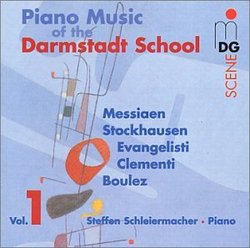| All Artists: Olivier Messiaen, Karlheinz Stockhausen, Franco Evangelisti, Aldo Clementi, Pierre Boulez, Steffen Schleiermacher Title: Piano Music of the Darmstadt School, Vol. 1 Members Wishing: 1 Total Copies: 0 Label: MD&G Records Release Date: 1/23/2001 Genre: Classical Styles: Chamber Music, Forms & Genres, Sonatas, Historical Periods, Classical (c.1770-1830), Modern, 20th, & 21st Century Number of Discs: 1 SwapaCD Credits: 1 UPC: 760623100425 |
Search - Olivier Messiaen, Karlheinz Stockhausen, Franco Evangelisti :: Piano Music of the Darmstadt School, Vol. 1
 | Olivier Messiaen, Karlheinz Stockhausen, Franco Evangelisti Piano Music of the Darmstadt School, Vol. 1 Genre: Classical
|
Larger Image |
CD Details |
CD ReviewsNice but introductory 11/22/2001 (4 out of 5 stars) "This pianist has already recorded lots of CD's with contemporary classics, including almost everything by Cage, but why a selection of the Darmstadt School's "greatest hits"? I hope that after some more volumes the series will include all Boulez's piano music from the 50's, all the first 11 piano pieces by Stockhausen, and also music by Berio and Barraquer. Let us wait and see." Darmstadt has come to mean more than this scarecrow | Chicago, Illinois United States | 02/16/2004 (4 out of 5 stars) "The new music seminars situated at Darmstadt that began after WW2 has become an important mecca retrospectively for contemporary music, anyone who is anybody has given talks there and has performed.(perhaps not Phil Glass, he found the music "scary")
The earliest generation is here those who began it as Karlheinz Stockhausen. If you have read any interviews with Pierre Boulez he claims he taught there only a few years. But Darmstadt was important in fashioning the post-Webern way of thinking post-dodecaphonic, 12 Tone Serial, where all the perameters of music tone, dynamic, articulation, duration was subjected to the "tyranny" of the 12, almost Kabballah-like minus the historical depth. And with any movement (as for instance Cubism Futurism, Dada) everyone who contributes to it brings/carves and finds/locates their own voice, and that certainly what has happened at Darmstadt. The "ends" of things in innovation in music were explored, and even Theodor Adorno(a generation older) was present arguing nicely and forcefully with the youngsters there that serialized music may have become a "sport" that was quickly exhausted by the end of the Fifties. Let's have a new work let's try this Adorno would exclaim, "how about a piece for Three Orchestras"" How about a piece for Voice and Percussion", How about a piece for Two Pianos", no innovation just "newness" for the sake of it"We haven't done that yet"Creators as Xenakis and Ligeti, and Penderecki certainly saw through this and another means(that of clusters, mists, arborencences) conceptually thinking about texture, timbre register. Boulez even said that he found it overly cumbersome to have to be forced to use all 12 Tones, when he was contented with writings exploiting the first 4 to 6.I was rather disappointed in the playing here save for the Boulez "trope" from his Third Sonata. This was wonderfully aggressive inventive playing, you really sense the deep musicianship of Boulez something his other Darmstadt brethren tended to ignore as Stockhausen. The Boulez Third Sonata has a massive pallette of timbre, the use of all the pianos pedals as well as the entire registers of the keyboard, attack, and arpeggiation, staccato mixed with sustained.You always need to find a direction of this music jumping in and oput of registers. It does have a direction, and if you become lost, Well! you stay lost. It was impassioned playing. Whereas the Stockhausen first 5 klavierstuck (piano pieces)(here referred to as Number 2,under one leaf book tyhat is)) were somewhat wihtdrawn timid and reserved. These pieces are about raw uninhibted timbre,lots of fortissimos, about musical space, High Middle and Low, Regions of excavations, (Loud is in front of you, Soft is hinterlands off in space) take yer ear oof. If you ever have heard Fredric Rzewski play these or the late David Tudor, or the Kontarsky Brothers (recall the early CBS-Box-Set Vinyl) this playing is rather uninspired. Perhaps all that John Cage playing has rendered the conceptual affinity for sound rather differently. These "klavierstuck" are incredible but you need to forget everything you have learned about the piano and simply think of it as a sound=producing box, like electronic music, simply register, klang. Likewise the Evangelisti was uninspired playing, much silnces with no real emotive of structural reason,quite boring,and it needn't be. Evangelisti died early unfortunately he was a wonderful contributor to the post Webern realm here and frequently utilizes graphic notation.The Messiaen work is rather long and difficult to sustain interest,it has more dimensions to it than readily apparent but this was one of Messiaen's more extroverted innovative works relatively speaking, for 'Vingt Regard sur l'enfant Jesus' is the massive encyclopedic dimensions of the modernist piano for which all other of his works is seen and judged." |

 Track Listings (14) - Disc #1
Track Listings (14) - Disc #1